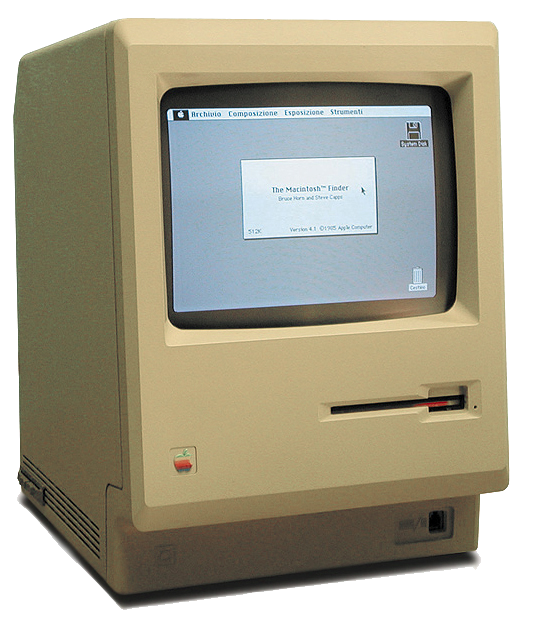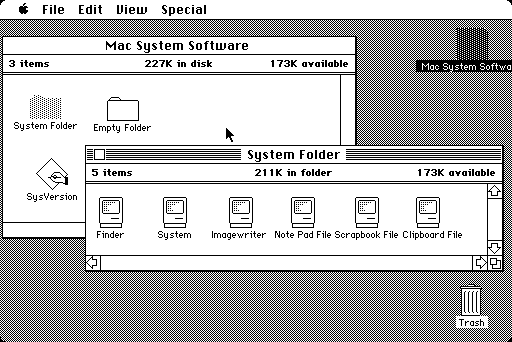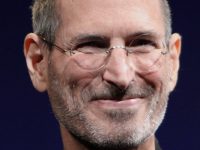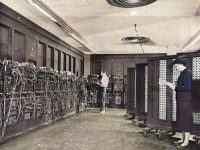
The Apple Macintosh (1984), photo: http://www.allaboutapple.com/, CC BY-SA 2.5 IT, via Wikimedia Commons
On January 24, 1984, Steve Jobs presented the the very first Macintosh computer, which became the first commercially successful personal computer with a mouse as standard input device and a user friendly graphical user interface to the public.
Apple Milestones
Although the 128K was not Apple Inc’s first computer on the market, it depicted a milestone. The Apple I was released in 1976, it was sold as a motherboard and would not fulfill today’s requirements for the term ‘personal computer‘, but just one year later, the Apple II glanced at the market with its cell based color graphics, its open architecture and the introduction of the floppy disk drive rivaling the TRS-80 and Commodore PET. Back then Apple faced a great start into their first sells due to the programm ‘VisiCalc‘, a spreadsheet program developed for the computer, making Apple computers suitable in people’s homes as in offices for serious calculations.
Another milestone set the computer ‘Lisa’ by the Apple company [2]. It depicted the first computer to feature a mouse as well as a graphical user interface and icons, the development was highly influenced by Xerox and up to this day it is not clear how big their influence actually was. However, Lisa’s technological improvements and its great usability were not of much use since the computer cost US$9,995 in 1983, when it was released. Unfortunately, the business success of Lisa failed to appear, but the company released the Macintosh 128K just one year later.
From McIntosh to Macintosh
The Macintosh is named after the apple variety McIntosh. The McIntosh was the favorite apple of Jef Raskin, who was a member of the Macintosh design team. An alternative name during the development period of the project was “Bicycle“: Apple co-founder Steve Jobs saw the computer ultimately called Macintosh as “Bicycle for your mind,” but due to the resistance of the development team, the new name did not prevail.[7]
The Art to present a New Computer
Historical was not only the computer itself, but also the way it was presented. Apple chose the famous Superbowl commercials as the right platform to present a commercial that definitely stayed in peoples minds. Created by Ridley Scott with a US$ 1.5 million budget, it aired during the third quarter of Super Bowl XVIII on January 22, 1984, and is now considered a “watershed event” and a “masterpiece”. It starts with a dystopic setting and a line of people marching through a monitored tunnel. Contrasts are used to emphasize the brightly colored runner wearing a cubist picture of the Macintosh carrying a large hammer while being chased by police men. Racing towards a huge screen showing ‘Big Brother’ giving a speech, she smashes the hammer right into the screen destroying it completely, while ‘Big Brother’ shouts “We shall prevail!“. The commercial ends with a voiceover and a scrolling text saying:
“On January 24th, Apple Computer will introduce Macintosh. And you’ll see why 1984 won’t be like 1984“.
The allusion to George Orwell‘s 1984 [5] overwhelmed the viewers and was hailed by the advertising industry as a masterpiece winning numerous awards. However, the television commercial and Steve Job’s demonstration two days later paved the way for a great commercial success of the company and its competitive position on the market.
Technical Innovations
But besides the special attention the Macintosh 128K received due to the commercial, it also came with many technical features guaranteeing its success. The improved graphical interface used the metaphor of a desktop and files appearing like paper sheets as well as the ability to drag and drop files into the ‘trash can’. More accessories on the desktop depicted a calculator, notepad and alarm clock which could be placed as desired. The machine was equipped with a Motorola 68000 microprocessor connected to 128 kB DRAM by a 16-bit data bus as well as with a 400 kB 3.5 inch single sided floppy disk drive.

The original Macintosh featured a radically new graphical user interface.
Commercial Success
Despite these innovations, the new computer sold only small quantities at the beginning. The reasons for this were seen in its high price and in the fact that its form and method of use were far removed from what was commonly understood at that time to be a professional computer (monitors with green writing on a black background and the input of long command lines). Only the successor models of the original Macintosh were able to attract a larger user base, which then achieved a high overall market share, but was overtaken by Windows systems in terms of numbers. The Macintosh 128K was sold about 70,000 times by May 1984 and superseded by the Macintosh 512K.
1984 Macintosh 128K/512K Teardown and Review, [9]
References and Further Reading:
- [1] Macintosh 128k History
- [2] Macintosh 128k at Computing History
- [3] 1984 Macintosh Commercial
- [4] Who remembers Apple’s Lisa?, SciHi Blog January 19, 2014.
- [5] George Orwell’s Opposition to Totalitarism, SciHi Blog, January 21, 2018
- [6] Intel 4004 – The World’s First Microprocessor, SciHi Blog, November 15, 2012
- [7] Steve Jobs – American Businessman, Inventor, and Industrial Designer, SciHi Blog
- [8] Apple Inc. at Wikidata
- [9] 1984 Macintosh 128K/512K Teardown and Review, TanRu Nomad @ youtube
- [10] Friedman, Ted (2005). “Chapter Five: Apple’s 1984”. Electric Dreams: Computers in American Culture. New York: NYU Press. pp. 100–120.
- [11] Hertzfeld, Andy. “folklore.org: Macintosh stories”.
- [12] Steve Jobs Timeline at Wikidata





